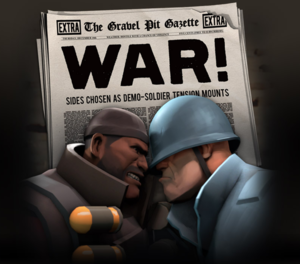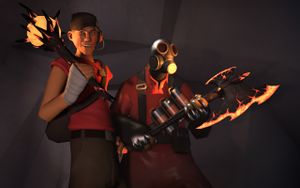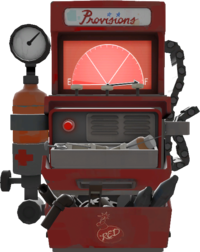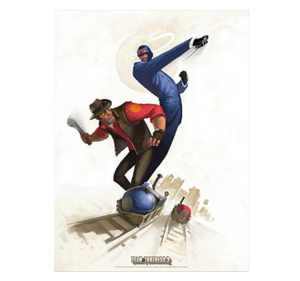Difference between revisions of "User:BEUFK/Sandbox"
m (→Artillery) |
m |
||
| Line 1: | Line 1: | ||
| + | {{User sandbox|noindex=yes}} | ||
{{ambox | {{ambox | ||
| type = notice | | type = notice | ||
Latest revision as of 11:45, 31 January 2024
 | Notice: This is the user sandbox of BEUFK. A user sandbox is a subpage of the user's user page. It serves as a testing spot and page development space for the user and is not an encyclopedic article. |
 | The user, User:BEUFK, hereby grant the following user(s) rights to make constructive edit on this page:
Any change which is considered as "destructive or unnecessary change" will be undone. |
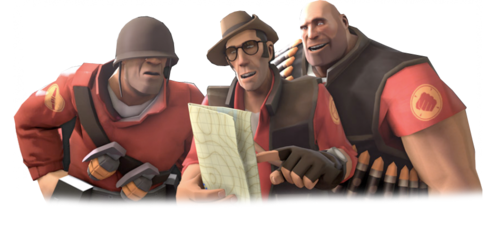
| “ | 干的漂亮!哦......那是敌方队伍的!
Click to listen
— 士兵 采用了不恰当的团队策略
|
” |
在《军团要塞2》中,若每一个人都自己独自战斗而缺乏团队合作精神的话,那么就很难取得游戏的胜利(其它团队类型游戏也是如此)。与你们队中其他队友合作是走向胜利的一个关键要素。
![]() 注意:本文章主要介绍如何与你的团队进行合理合作的一些小提示,若想查看关于提升自身技术的文章,请查看策略,若想查看单个地图的相关策略,请查看各个地图页面所留下的“策略”这一章节。
注意:本文章主要介绍如何与你的团队进行合理合作的一些小提示,若想查看关于提升自身技术的文章,请查看策略,若想查看单个地图的相关策略,请查看各个地图页面所留下的“策略”这一章节。
Contents
一般战术
沟通
《军团要塞2》中并没有“真正意义上”的小地图,且其作为一个团队协作游戏,沟通与合作就显得尤为重要。队友之间的配合与合适的兵种搭配可以为团队的胜利增砖添瓦。抛开技术来讲,沟通也是一门有技术的工作,无论是用语音命令还是开麦,一个善于沟通的队伍定能打败一队缺少沟通的“大神”。在竞技类游戏中,有效的团队沟通与协调显得更为重要。
在游戏中,你可以使用语音命令与打字框与队友沟通。但是,鉴于很多人不会关注你的语音或文本,还是建议你使用麦克风与队友交谈。在交谈中,你可以为团队传递一些有用的信息,比如敌方间谍的位置与伪装身份、步哨枪与黏弹的位置、进攻的最佳时机以及我方(或敌方)的ÜberCharge积攒情况等。一般的语音命令或打字无法如此有效的传递以上信息。
然而,值得注意的是,某些服务器开启了“全局聊天”模式,这样全部玩家都能看到你的发言。在这样的情况下,还是最好用团队聊天(在控制台中输入say_team+文本内容),否则一些关键信息会被敌方窃取到。不过,“全局聊天”模式一般只在一些公共服务器上开启,那里的玩家不会太过于注重游戏的胜负。
合理的团队组成结构
《军团要塞2》是一款多兵种游戏,在游戏中,同一队玩家之间需要互相协调与配合才能走向胜利。九个不同的兵种各有长处与短处,每个兵种也有不同的游玩风格,玩家们需要扬长避短,发扬兵种的最大优势。然而,就算是游戏中最厉害的玩家也无法完全弥补他所玩的兵种的优势,而一个新手在某些场景下也可以干掉那些厉害的玩家(比如:一个不怎么会玩的Pyro可以压制一个高技术的Spy)。这让兵种选择变得十分重要,并且,玩家可以借机多练一练其它的兵种。当然,团队的合作也十分重要,你可以把它当作一个复杂版的“剪刀石头布”游戏。
新手玩家最容易犯的错误是热衷于单打独斗:总是选择自己喜欢玩的兵种而忽略团队需要,总是选择单打独斗却忘记了一个事实——在游戏中,大多都是团队之间,不同兵种搭配的作战。因此,己方队伍想要胜利的话,每一个团队的队员应该协同合作,为团队着想,这就要求玩家注意我方与敌方的兵种搭配。在大部分局面下,我方可以选择几个用于克制敌方兵种的兵种以取得优势(比如:Medic与Demoman组合,去解决敌方的Engineer的建筑群)。然而,需要注意的是:不能为了克制敌方单个兵种而导致己方队伍兵种配置进行大规模换动(举个例子,敌方Spy有点多,于是我方几乎全部换为Pyro。我方的防御能力也就大大下降了)。推荐过一段时间就看一下计分板以随时调整兵种。在标准的12v12中,配置为:(两支队伍一共)两个侦察兵、两个士兵、两个火焰兵、两个爆破手、两个机枪手、两个工程师、两个狙击手、两个医生和两个间谍,而剩余四个槽位应在士兵、爆破手、机枪手与医生之间挑选(其中医生总数不超过三个,极端情况不超过四个)。
练习
在游戏中,了解多个兵种的玩法总比只了解一个好。知道兵种的长处与短处,这样你才能选择合适的兵种应对当前的局面。同时,你还需要了解每个兵种所能承担的职责。举个反面例子:在夺旗模式中,你在聊天框内把你们队唯一一个Engineer叫过去当医生来帮你们偷情报。但是,这样做带来的后果就是自家的情报无人防守。总的来说,比起疯狂叫别人换成医生,不如在自己清闲的时候去当队里唯一的医生。
从另一方面来讲,花大量的时间在同一个兵种上并不是个好主意。首先,你真的需要许多许多的时间来练这一个兵种,其次,当你在玩你那些还不熟练的其它兵种时,你会成为队伍的累赘。所以说,平常还是练个2~3个自己比较熟练的,再练2~3个相对较为熟练的。否则,如果你选择九个兵种都一起练的话,最终你只会每个兵种的一点皮毛,却掌握不了他们的精髓。
还有,尝试去寻找一个符合你的游戏风格的策略,再去集中练习相应的兵种。记住,不是每一个人都会熟练地玩Spy背刺别人,也不是所有人都会用Sniper爆别人的头。有些玩家就是适合在幕前幕后给队友默默地支持,有些玩家喜欢从远距离放倒敌人,还有些玩家喜欢喜欢近距离独自战斗(当然,团队配合为上)。所以说,寻找你最适合/最喜欢的兵种,再挑选最适合你的战术以勤加练习。但是,也不能对自己要求太过于高,因为练习的目的是为了让你大致熟悉你所使用的兵种/战术,而不是完全地掌握它。如果你发现你就是适应不了某个兵种/策略的风格,那就放弃它吧,把时间投入到练习那些你更能适应的兵种/策略。
兵种
《军团要塞2》的核心玩法就是九个兵种与他们的队友/敌人之间的“交互”。 就算你只了解了他们其中的基本玩法,这也将大大帮助你去了解游戏的大致内容以及兵种所能干的事情。每一个兵种都有自己独特的属性,而这些属性(包括生命值、移动速度、所能装备的武器以及一些角色基本属性,例如二段跳或是生命恢复)决定了他们的优缺点。该章节对所有兵种进行了分类,意在让读者了解如何将不同兵种配合起来以变得更加强大。注意:该分类不是按照所谓“官方”的兵种分配方式(即进攻、防守、支持),这么做是为了帮助读者找到同个分类的不同兵种的策略上或游玩风格上的相似点,而不是单一地以其默认的战斗方式/玩法风格分类。
第一组:战斗小组
- 特征: 所有该组的兵种都有着以下的特点:火力十足、生存能力强或者其高机动性(有的时候三者皆有)。上方兵种(除了侦察兵)在没有超量治疗的情况下基准生命值都能在175~300之间。而且,由于他们的高火力输出,以及他们在战斗的最前线出场最频繁,Medic的ÜberCharge也会优先给他们。还有,这个组里大多数的兵种都有可以给影响敌方移动的武器(比如机枪手的Natascha、侦察兵的Force-A-Nature和Sandman。而火箭、榴弹、黏弹与火焰兵的压缩气爆可以把敌人吹/炸来吹/炸去)。这五个兵种的几个能力都可以大大提升他们的机动性,使得他们一进游戏就能投入战斗,不需要特定的位置或者是太长的准备时间。
- 团队职责: 他们作为一个团队的重要组成部分,总是出现在战斗最前线。这四个兵种地主要职责是:1.带领推进敌方控制区域;2.保卫我方的目标。在条件允许的情况下,他们的战术风格会十分激进。衡量一个战斗小组成员的能力的数据就是他们的击杀数和所制造的伤害。该组的成员一般有能力与其他任何兵种1v1单挑。一般来说,一个由所有该小组的成员组成的队伍不会出现太过于大的问题。但如果他们想要突破敌方的防线,或者是打持久战,他们就需要来自第二组和第三组的帮助。还有,他们还承担着保护其他组成员的职责,尤其是那些支援兵种。Medic和Engineer必须存活下来,以发挥他们的更大优势,第一组的成员必须保护他们免遭敌方第一组或者是第三组的攻击。工程师建造和维护他的建筑,同时这些建筑也帮助着团队,它们应该被视作“公共财产”,由大家共同呵护。为了更好地保护他们,尽量将一些拾取物留给他们。
火炮进攻小组
- 特征: 这两个兵种都由能力制造高伤害,拥有着大攻击范围、强恢复能力以及高机动性。从某种意义上说,他们所持的武器也有着许多相同点:Rocket Launcher和Grenade Launcher的本身伤害都很高,其所附的溅射伤害更是可以一次击中多个敌人。 Demoman的主武器允许爆破手干掉那些不在自己视线里的敌人。不只如此,这些属性再与他们“Fire and Forget”的能力结合在一起时,可以使得他们变得更加强大。他们十分擅长处理那些工程师的步哨,在爆击加成下他们显得更加恐怖——能用一点点弹药将敌人全部炸成残渣。他们同时具备“爆炸物跳跃能力”,以血量作为代价换取机动性,能让他们从多个角度发起突然攻击,或者是让他们逃跑。总的来说,他们并没有什么十分明显的劣势,但是他们在某些地方上存在着不足:他们两人的武器在攻击时很容易伤害自己,特别对于爆破手,鉴于爆破手没有霰弹枪类武器,这也意味着他很难在近距离解决掉一个类似Scout这样高机动性的兵种。更要命的是,所有的“发射器”类武器的弹夹弹药较少,且换弹时间较长。对于想玩好这两个兵种的人来讲,如何在正确的时间换弹确实是一个十分需要技巧的东西,毕竟,你的“换弹癌”可能会要了你的命!同时,经常换弹这一需求会导致他们在独自处理一大波敌人时显得十分窘迫。需要注意的是,火箭与榴弹属于“延时弹道”,有技巧的敌人可以躲过你的攻击,无论你当初瞄地多准。
- 团队职责:在中程距离制造大量伤害,逼迫敌人从掩体里或者是步哨群里跑出来。他们的主要职责就是尽可能地制造伤害,而稍有懈怠则会导致敌人卷土从来。除此之外,他们的一个主要优点就是没有很多其他兵种的缺点,因此,他们总是作为进攻或是防守的主干力量。因为他们的武器可以制造巨额伤害,使得队友能更好击倒敌人。
Close combat
- Characteristics: While also belonging to Group 1, the "general combatants", the members of this group are distinguished by a few things. Namely, they have more pronounced strengths, but also more pronounced weaknesses than the artillery classes, creating trade-offs, along with a few more specialized roles such as Spy checking and objective-grabbing. The Heavy has the highest health of any class but also the lowest mobility especially while attacking; the Pyro is devastating at close range and when appearing unexpectedly, but conversely has very low damage potential at mid and long range, and is usually not as much of a threat without the element of surprise. The Scout by contrast is the fastest and most agile class but has the lowest health out of the Group 1 classes. All three classes in this group can do tremendous damage over time, however in order to do so they must usually 1) be at close range and 2) have line of sight to their target. This in turn means that they can easily take as much damage as they receive, often requiring class-specific tactics in order to survive. For the Pyro, this means ambushing and taking advantage of distractions, for the Scout it is using his superior agility to avoid damage, and for the Heavy it means relying on Group 2 for Healing and transportation. The reliance on line of sight attacks also makes this group much less effective against Sentry Guns than the artillery classes. The Pyro is the most effective Spy checking class on the team, able to expose both cloaked and disguised Spies with ease. The Pyro and the Heavy are unique in that their Primary weapons, the Flamethrower and Minigun, never need to be reloaded and can fire continuously until depleted. This can enable them to provide invaluable support to the other Classes during prolonged fights where enemies are streaming in constantly. This can also make them amazingly effective ÜberCharge recipients, able to utilize the entire period of invulnerability to the fullest possible effect.
- Team Role: This group of classes is the most easily held at bay by enemy Sentry Gun positions. Teams that are relying too heavily on the classes in this group often have a difficult time defeating a team that is "turtling" or defending; once enemy Sentry Guns have been eliminated however, they can freely enter enemy territory and wreak havoc. This group is also very good at working with and protecting allied support classes – Pyros work synergistically with Engineers and both Pyros and Heavies work very well with friendly Medics. This group is also very good at punishing enemy teams that neglect having enough Group 2 classes to heal and restrict their movement with Sentry Guns. Without enough healing, fire can deal a huge amount of damage through afterburn, and the "hitscan" bullet damage of Heavies and Scouts with good aim can't be easily dodged and can quickly erode enemy health. Finally, all three classes in this group are very effective at contesting objectives of various types. Heavies have the staying power to stay on dropped Intelligence, Capture points, and Carts and lay down suppressing fire. Pyros have unique abilities to keep Spies away from objectives and can also physically prevent enemies from contesting objectives by using the Compression Blast to push them back. Finally, the Scout can use his natural speed and extra capture force to accomplish objectives faster than any other class.
Group 2 - Support
- Common Characteristics: By far the most team-oriented classes, the Engineer and Medic are the only classes that can provide reliable healing to their allies, often several at once, greatly reducing team losses due to simple attrition. For this reason alone, almost any team of any size greater than one on any map will benefit from having at least one support class, however the usefulness of the support classes increases as team size increases. They largely lack powerful combat abilities of their own, having low hitpoints (125-150) with average mobility and weak ranged weaponry, and therefore must contribute to their team's success through their support skills. These skills are very powerful however, and have a huge impact on the game – Medics and Engineers are much more than simply glorified Health and Ammunition pickups for the other classes. The Engineer's support skills take the form of his Buildings, while the Medic's take the form of the ability to provide overhealing buffs to multiple teammates, and the game-changing ÜberCharge. For both classes, bringing these assets to bear in a game takes time – both ÜberCharges and fully upgraded Buildings can take quite some time to reach their full potential, often a minute or more of game time. In a game as fast-paced as Team Fortress 2, that's a small eternity. Many game types have a Setup time to accommodate the support classes and allow them to contribute at full power right from the beginning of the mission. Good Engineers and Medics will do everything they can to speed up the process of building their ÜberCharges and buildings. The long "build" times of the Medic and Engineer define the success of their gameplay in terms of their own survival and not in getting kills. Both classes must play very cautiously to avoid death, to survive long enough to provide ÜberCharges and maintain buildings. A support class who dies at a critical moment can cost their team victory.
- Team Role: Providing healing and resupply to allies in the field, reducing team losses due to attrition, and allowing teammates to hold positions while under constant enemy pressure, or apply constant pressure of their own. Sentry Guns and overhealed/invulnerable teammates are very good at absorbing and shrugging off damage. Support is given to any and all teammates, but is most effective when given to the general combat classes of Group 1 who will usually take the brunt of enemy attacks, and often die and need to return to the battle quickly upon respawning. Medics and Engineers can support each other quite effectively as well and should do so whenever the opportunity arises. For example, Medics can provide ÜberCharges to allied Kritzkrieg Medics or Engineers under heavy fire, while Engineers can repair, build, and upgrade the Buildings of other friendly Engineers. The support classes need to watch out for the attacks of enemy Group 3 classes, the Sniper and Spy, since they are often the priority targets of these enemies. Help from Group 1 and 3 is often necessary to stay alive. Finally, the support classes can break the back of the enemy team on the attack or ensure a successful defense of an objective through a well executed ÜberCharge or well-placed Sentry Gun. In terms of team composition, an reliance on a large number of support classes is almost never a good idea. While they can provide very powerful support abilities, Medics and Engineers themselves don't actually fight all that well, and every player who plays a support class is not playing a class that can fight off the enemy, and increases the burden proportionately on the smaller number of teammates who are playing a class from Groups 1 or 3. Engineer or Medic heavy teams can also be a dream come true for enemy Snipers and Spies, whose skills are quite capable of countering the support classes. The power of the support classes is their ability to help out a large number of their teammates easily, and to take fullest advantage of this it is wise not to have too many team spots devoted to Support.
Group 3 - Assassination
- Characteristics: While both possessing similarly low Health (70-125) and average movement speed, the most obvious similarity of these two classes is their shared ability to instantly kill any opponent with a single attack, largely regardless of target health. They both rely on good positioning, skillful aim, and patience to get their kills. While the success of the Group 3 classes is also to some extent measured by how many enemies they kill before they themselves die, unlike Group 1, who they kill is usually more important than how many. A Spy that reveals his position and sacrifices his life to stab an enemy Soldier is of questionable value – but taking out an enemy Medic with full Über can be game-changing and is well-worth dying for. Both the Sniper and Spy avoid the front lines due to their low health, and instead operate behind the lines – the Sniper behind his allies' lines, and the Spy behind his enemies'. Both classes are also better than any other class at picking off opponents who are trying to hide behind their allies, such as Medics.
- Team Role: Precision elimination of key enemy targets. These can be very talented enemy players that your team is having trouble with, or they can be resilient targets such as Heavies, or they can be high-value targets such as Medics and Engineers. The assassin classes are at their most valuable at countering the influence of the Group 2 support classes. Headshots and Backstabs can cut right through the healing and overhealing of Medics and eliminate Engineers hiding behind their Sentry Guns. The Spy in particular is designed with the ability to disable and destroy Engineers and their buildings. The support classes also try to stay alive at all costs so that they can build up their power and provide constant benefit to their team. Death is a much bigger setback to Engineers and Medics than it is for any other class, and the assassins from Group 3 are sometimes the only classes capable of killing them even when they are surrounded by formidable defenses. The Sniper and Spy also tend to end up locking horns with their counterparts from Group 3 due to where and how they fight. The ability to pick off key enemies can break stalemates, and the psychological effect of Snipers and Spies can split the concentration of enemies and make them reluctant to push forward. The ability of Spies in particular to attack enemies in areas where they expect to be secure can have a huge overall impact on enemy defenses. A team with very effective Snipers and Spies, if left unchecked, can easily run away with a game. However there are several reasons why having too many of Group 3 classes on a team is a very bad idea. Snipers and Spies operate "behind the lines" - or at arms' length - and rely on not being the immediate target of the enemy in order to kill distracted players who are not expecting them. However, not having enough general combat classes means the enemy team will be less occupied and much more able to focus on eliminating Snipers and Spies. Not only that, but having a lot of Spies quickly becomes counterproductive as the enemy team becomes aware of it. One Spy that still has the element of surprise is much more effective than several that are constantly getting discovered and killed. If you are playing as the Spy or Sniper and not having a very good day, it may not be your fault. It may be the fault of your team's composition.
Team tactics
These are strategies in Team Fortress 2 that most players should learn and understand to help their team achieve victory. Using these in combat will allow your team to possibly have an advantage in a match.
- Find alternate routes and use them to get behind the enemy or Capture points, but keep in mind how much extra time this will take. Do not take the same flanking route too often to avoid becoming predictable, as the enemy will quickly learn from their mistakes and anticipate your strategy.
- Wait around corners and surprise your enemy. Your team could wait around corners and ambush any enemies that walk by as a defensive or offensive tactic.
- Communicate with your Medic buddy. Try not to waste your ÜberCharge, but remember that it is better to spend your charge and survive than to die with a charge ready. Have a plan for what you will do when ÜberCharged.
The Barrage
- Overview: An advancing push involving heavy usage of explosives by Artillerymen to clear the way for the rest of the team.
- Details: Demomen and Soldiers will continually blast explosives into an area to make it a no man's land in order for the opposing team to lose ground. Normally, close combatants will follow the barrage by moving into the cleared area and holding it. The Demomen and Soldiers will continue to spread out across the intended area to ensure it is all cleared.
Über push
- Overview: A series of ÜberCharges which are used to clear an area.
- Details: Two or more Medics will build up separate ÜberCharges. The first Medic activates his charge and enters the area; after 9 seconds, the second Medic follows in suit. If the situation turns for the worst, the second Medic will follow immediately and take advantage of the distraction provided by the first ÜberCharged pair. The second Medic will proceed to move deeper into enemy territory before activating the second charge. Communicating who will ÜberCharge first is key.
Minefield
- Overview: A series of stickybombs over an open area laid by Demomen.
- Details: Several Demomen will spread out a carpet of Stickybombs over an open area in sequence. When attackers push forward, they will detonate each set of Stickybombs at certain key points to kill multiple waves of attackers. It is important that the other Demomen wait for the previous set to be detonated before detonating the next set. Using the Scottish Resistance makes this strategy more efficient, easier to pull off, and somewhat lessens the need for multiple Demomen since a single Demoman can have up to 14 stickies and selectively detonate them. A counter-attack for this strategy is using a Pyro's compression blast or using sticky bombs to counter-detonate the enemy stickybombs.
Coordinated sap
- Overview: The sapping of Sentry Gun emplacements by Spies, to enable an attack by teammates.
- Details: Team of Spies will conjure together to sap Sentry Gun emplacements just before an offensive push which enables teammates to safely attack the disabled Sentry Guns and Engineers. The Spies will then communicate when they have sapped the Sentry Gun to enable the attack to commence immediately. They will continue to sap to enable the rest of their teammates to take out the Engineer first. Alternately, the Spies may take out the Engineers while they are being distracted by the attack.
Medic luring
- Overview: When a Spy, disguised as a Medic buddy, lures Medics into ambush points.
- Details: Instead of attempting to kill an enemy Medic, the Spy will disguise as an enemy assault class. He will attempt to lure an unaware Medic into an ambush. Thinking he is a member of his own team, the Medic may follow you into your team's base, allowing your team to ambush him with a Sentry Gun or a group of allies. Remember that Spies look less suspicious when they appear to be trying to help the team.
Rushing
- Overview: All players select the same class to overwhelm the enemy.
- Details: All players choose only one class or a majority of one class. The class usually depends on the situation. For example, a Scout rush allows your team to reach and capture the first point very quickly, hopefully before the entire enemy team arrives. Classes such as Spies or Snipers are not recommended for rushes. The enemy team, with a team composition meant to meet the enemy team, will be unprepared for a swarm of Soldiers when they have only two or three to respond with.
Tactical direction
- Overview: In certain maps, your team will have to decide whether to go one path or another.
- Details: This decision usually comes into play in 3-CP maps such as Gravel Pit.
The Train
- Overview: A large amount of Heavies that will clear and defeat enemies due to their enormous amount of firepower and Health.
- Details: A "Heavy" train is useful in many game modes especially capture point modes because this allows them to capture points with ease and provide a barrage of fire power in order to protect their own capture points. This is also very useful in Payload, where the Heavies can stick close to the cart, or in some cases, let the cart move the by standing in front of the cart or on top, and because the cart comes with a Dispenser, it will make sure Heavy's ammo problem is minimized. This is useful in maps like Payload Frontier where the train has a big platform the Heavies can stand on. The Heavies can be interspersed with Medics for a greater effect. This strategy is not recommended on maps/gamemodes where speed is key, such as Capture the flag, Robot Destruction, or Special Delivery. Two Heavies working together when pushing the cart on Payload races can fight off anything that comes their way.
The only problem with this strategy is that the Heavies are completely helpless at long range. Enemy Snipers can easily pick off Heavies due to their large hitboxes and slow movement speed, but they are a problem that can be easily dealt with your own Snipers or Spies.
The Ninjaneer
- Overview: A party of players (usually a fast close combat class such as a Demoman, Scout, or Pyro) escorts a Engineer behind enemy lines, where he can build a teleporter for a surprise attack on the enemy.
- Details: Ninjaneers are useful during Payload and certain Capture the Flag and Control Point maps. Common examples are the opposing team's sewers at 2Fort, and the house at Red spawn in Badwater Basin, and at the last point in Payload Upward, before the enemy starts spawning there. It is often best that the teleporter is built in a closed location, so that the other team cannot find it as easily. It should be advisable to put at most a Level 2 Sentry along with it, as they are less noticeable and will protect your teleporter when your teammates are not defending it.
The French Connection
- Overview: Two Spies that walk together to minimize suspicion by the enemy team.
- Details: This is very useful for clearing a group of enemies pushing the cart on Payload, or taking out an advancing group assuming you are coming from the enemy's direction, or clearing out a sentry nest. Enemies will often mistake the two Spies for teammates, as they are walking together, and thus not bumping into each other (which, naturally, is a primary way to know if there is a disguised Spy about). With this, there is less chance that the enemy will shoot you to spycheck. If a Spy is spotted, and often after finding one, enemy players will suspect they've found the only Spy in the area and stop Spy-checking. However, if you stand too close to the other Spy, then you might get spotted as well. Consider bailing out on your teammate if he is getting attacked — after all, having one Spy down is better than both of them down.
Entrenchment
- Overview: Three or four Engineers construct multiple Sentry nests in close proximity.
- Details: In game modes such as Payload, massive sentry nests can stall the opposing team for an entire game session. Remember to always be near the Sentry nest as large construction projects of this magnitude will always attract hordes of Spies trying to Sap your creations. Always have at least one Teleporter within a sentry nest, as powerful as a Level 3 Sentry Gun is, it can't move. Be careful to not place these right next to each other, as that will make it easy to blow them all up in one go.
Level 3 Sentry Guns have one weakness - their range. No matter how many are deployed in a sentry fort, all of them will be wiped out if you let them come into contact with Soldiers and Snipers. Use what is given to you to your advantage when defending - you cannot stress this enough, as 730 metal does not come out of nowhere, other than the Resupply Cabinet.
Scout Swarm
- Overview: Similar to a Scout rush, but when four or five Scouts all go for the same target, such as a powerful Heavy-Medic pair or a horde of Soldiers.
- Details This is when a group of Scouts work as a pack, following each other across the map and attacking anyone who gets close to them. This is brilliant when you want to launch an unexpected attack on a Control Point or Payload Cart, and leaves the enemy struggling to hit the Scouts racing past them. Working as a dog pack as a Scout requires serious coordination, which is not easily done. However, a successful Scout pack will be a serious problem for the enemy team, probably the only major threat is a Sentry Gun - avoid them at all costs.
See also
|
